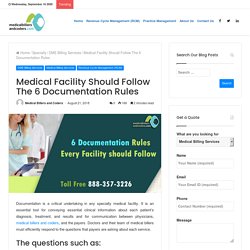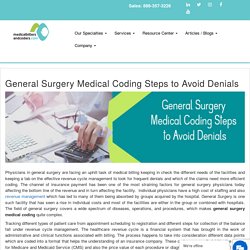Zoom
Trash

Alicecarlosmbc
Accounts receivable: How to read a complicated AR report very easily? Medical billing reports are a key barometer for understanding what’s going on in your medical practice.

Without good reporting, it’s difficult to determine whether your practice is making money or not. What is an ideal denial percentage? Yes, there will always be some denials. The denial rate represents the percentage of claims denied by payers during a given period and quantifies the effectiveness of your revenue cycle management process.

A low denial rate indicates a healthy cash flow. A 5% to 10% denial rate is the industry average; keeping the denial rate below 5% is more desirable. Medicare Enrollment Application Information: MBC. CMS received approval for a new Medicare Enrollment Application for physicians and non-physician practitioners (CMS-855I dated 12/2018).

Many changes are minor; the major ones reduce provider burden: Eliminated reporting for advanced diagnostic imaging, Clinical Laboratory Improvement Amendments number, and the Food and Drug Administration radiology certification numberExpanded instructions for individual and group affiliations to simplify reportingMade it optional to list a contact personAdded electronic storage information for those who no longer keep paper recordsCreated a more logical data flow You may begin using the new application immediately.
Through April 30, Administrative Contractors will accept applications dated 7/2011, but after that, you have to use the new version. Submitting an Application: Medicare enrollment application forms are fillable on your computer. Reference Link: Medicine Services: Mistakes To Avoid While Coding. Medical Coding is more complicated today with different overviews regarding medical codes according to the insurance companies.

Medical Billars and Coders: How to prevent AR issues in Hospital Billing? Is your hospital facility billing continuously facing errors?

Within any of your medical accounts in terms of Revenue Cycle Management (RCM) is that restricting your organization’s cash flow? There are a few common problems that have affected the current Hospital Billing setting which can be avoided in a few steps. Claim Denials One of the easiest problems which can be observed in any AR management is claim denials. If you have probably read about it that in hospital billing of all the claims total of 10 to 25 percent of them are denied on an average.
The claim denial problem is pretty real and less than two-fifths of the appeal of the practice during a denial. Insurance companies have issued a statement that most of the denials are due to simple errors and can be fixed with a certain amount of attention. Billing write-offs Some of the write-offs may be necessary while dealing with claims but unnecessary write-off can be cumbersome for your practice. Write off between amounts Monitoring. Medical Facility Should Follow The 6 Documentation Rules.
Documentation is a critical undertaking in any specialty medical facility.

It is an essential tool for conveying essential clinical information about each patient’s diagnosis, treatment, and results and for communication between physicians, medical billers and coders, and the payers. Doctors and their team of medical billers must efficiently respond to the questions that payers are asking about each service. The questions such as: Urology billing suffering due to stagnant coding: Medical Billers and Coders. Urology billing is seeing a pool of billing and coding changes both in terms of administrative workflow and coding for different procedures.

It might be time for you to understand different aspects of urology coding and how the insurance company will like you to work as a facility. As a Urologist, your in-house restorative charging and coding staff successfully revealing CPT 2016 code changes, including new and rethought E/M codes for postponed administrations and methods? Is it genuine that you are disappointed by many code enlargements for mixture techniques that are prompting an expanded number of charging and coding blunders?
Is it right to state that you as a qualified Urologist are searching for remarkable alternatives to streamline the work procedure? All things considered, on the off chance that it is the situation, at that point apportioning the critical workload to outsourced charging and coding office is the best choice accessible for you. How Your AR Determines Your ASCs Financial Future. AR is the average number of days it takes practice to collect payments due.

This metric provides valuable insight into the overall efficiency of your revenue cycle. A lower AR implies faster payment—a necessity in today’s self-pay and high-deductible health plan environment. Physicians need to collect every dollar that’s due to them as quickly as possible. All practices should strive for an average 40-day AR cycle to ensure smooth cash flow and operations. To determine your average AR, divide your total accounts receivable by your average daily gross charge. Timely and accurate Ambulatory Surgical Center Account Receivable billing and collections can have a dramatic impact on the overall success of the ambulatory surgery center.
Ensure That Preadmission Process Is Error-free. General Surgery Medical Billing and Coding Steps to Avoid Denials. Physicians in general surgery are facing an uphill task of medical billing keeping in check the different needs of the facilities and keeping a tab on the effective revenue cycle management to look for frequent denials and which of the claims need more efficient coding.

The channel of insurance payment has been one of the most straining factors for general surgery physicians today affecting the bottom line of the revenue and in-turn affecting the facility. Individual physicians have the high cost of staffing and also revenue management this has led to many of them being absorbed by groups of acquired by the hospital. General Surgery is one such facility which has seen the rise of individual cost and most of the facilities are either in the group or combined with hospitals. Tracking different types of patient care from appointment scheduling to registration and different steps for collection of the balance fall under the revenue cycle management.